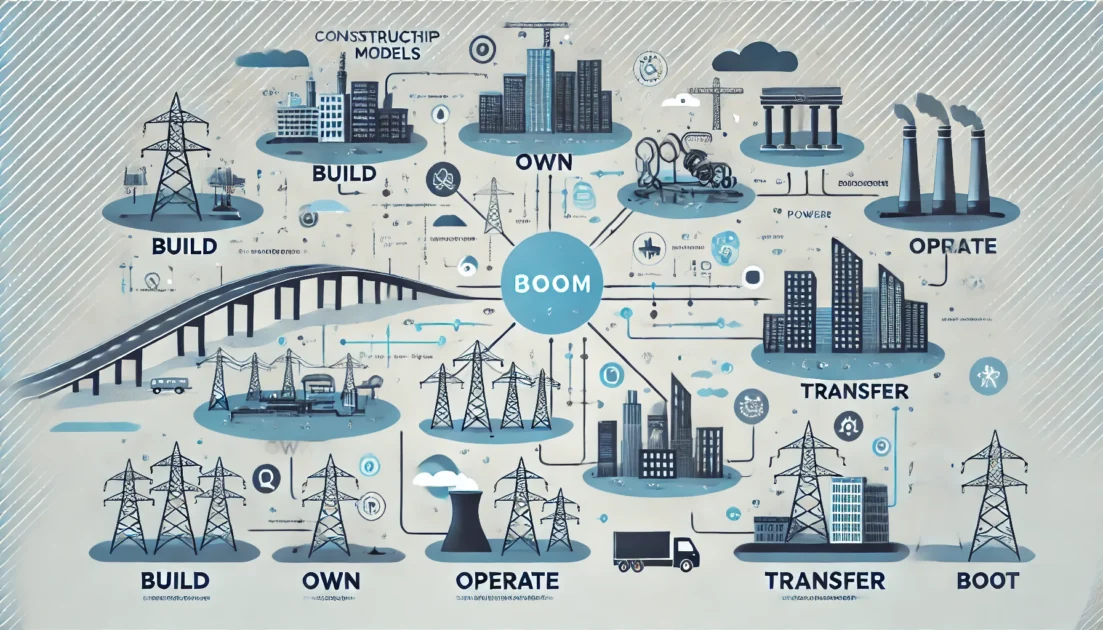
Tendering processes and methods are crucial in the development and execution of construction projects, especially in sectors like power and infrastructure. These processes help ensure transparency, competitiveness, and efficiency in project delivery. Additionally, different ownership models such as BOO (Build-Own-Operate), BOOM (Build-Own-Operate-Maintain), and BOOT (Build-Own-Operate-Transfer) play a significant role in structuring project financing and management. Let’s delve into these aspects in detail.
1. Overview of Tendering Processes
Tendering is the procedure by which organizations (public or private) invite bids for large projects that must be submitted within a specific deadline. It aims to select a suitable contractor or consortium capable of delivering the project efficiently and cost-effectively. There are several common types of tendering processes:
Open Tendering: Any interested party can submit a bid, and the process is transparent, encouraging competition. It is widely used in public procurement where transparency is critical.
Selective Tendering: The client invites only a selected number of firms to submit their bids. This process is often used when the client wants to ensure that only competent and reliable contractors with relevant experience participate.
Negotiated Tendering: The client negotiates directly with one or a few contractors, often used when time is critical, or the project is complex.
Two-Stage Tendering: In the first stage, the client selects a contractor based on their competence and proposal. In the second stage, the details of the project and the costs are finalized through negotiation. This approach helps reduce risks associated with cost overruns.
2. Methods of Project Delivery
Project delivery methods vary based on the extent of involvement and responsibility assumed by the client and contractor. Some common methods include:
Design-Bid-Build (DBB): The traditional approach is where the client designs the project, and contractors bid to build it. The client maintains ownership of the project throughout its lifecycle.
Design-Build (DB): A single entity handles both design and construction, reducing the risks for the client and potentially shortening the project timeline.
Integrated Project Delivery (IPD): This collaborative approach involves all key stakeholders (client, designer, contractor, etc.) from the beginning, promoting teamwork and shared responsibilities.
3. Construction Ownership Types
In large-scale infrastructure projects, especially those involving public-private partnerships (PPPs), ownership models define the role of private entities in financing, operating, and maintaining projects. Common construction ownership models include:
BOO (Build-Own-Operate): In this model, a private entity builds, owns, and operates the project without transferring ownership to the government or another entity. It is typical for long-term projects like power plants or toll roads.
BOOM (Build-Own-Operate-Maintain): Similar to BOO, the private entity is also responsible for the maintenance of the infrastructure throughout its operational life, ensuring consistent performance.
BOOT (Build-Own-Operate-Transfer): This model involves the private sector building, owning, and operating a facility for a specified period. After that period, ownership and responsibility are transferred to the government or another party. It is common for infrastructure projects where public ownership is necessary in the long run, such as highways and bridges.
BOT (Build-Operate-Transfer): This approach is similar to BOOT but typically focuses only on construction and operation, with maintenance responsibilities often falling to the new owner post-transfer.
DBFO (Design-Build-Finance-Operate): The private sector designs, builds, finances, and operates the project, with an option to transfer ownership later. It is usually used when the public sector wants to delegate most responsibilities while maintaining ownership in the future.
4. Financial Ownership Types in Projects
The financial structuring of projects also involves various ownership models where the roles and responsibilities of financing, operation, and ownership differ:
Equity Financing: Investors, often private firms or financial institutions, contribute capital in exchange for equity ownership in the project. These entities assume a proportionate share of the profits and risks associated with the project’s performance.
Debt Financing: Project owners borrow funds from banks or financial institutions, which are repaid over time with interest. This approach allows owners to leverage their equity, but they bear the financial risk if the project underperforms.
Public-Private Partnership (PPP): In PPPs, public entities collaborate with private firms, combining public funding or support (such as land or tax incentives) with private investment. The private sector typically manages construction and operations, while the government might retain some oversight or take over operations post-transfer.
Concessions: In concession agreements, the government grants a private entity the right to build and operate a facility for a specified period, after which the ownership may revert to the government. It is a common model for utilities and transportation projects.
5. Factors Influencing the Choice of Tendering and Ownership Models
The selection of tendering processes and ownership models depends on several factors:
Project Type and Size: Larger and more complex projects, such as power plants, airports, and highways, often use PPP models like BOOT or BOT to share risks and investments between public and private entities.
Risk Allocation: The government may prefer models where risks, such as construction delays or maintenance costs, are transferred to private entities, especially for projects with uncertain returns.
Funding Availability: Public sector limitations in funding often necessitate private participation through models like BOOT or DBFO, ensuring project viability while minimizing public expenditure.
Conclusion
Understanding tendering processes and ownership models is essential for stakeholders in the construction and infrastructure sectors. These models determine how risks are shared, how funding is structured, and how projects are ultimately delivered and maintained. Each model offers advantages and challenges, making it important to tailor the approach to the specific needs of the project and its stakeholders. As the power sector continues to grow, especially with renewable energy projects, the choice of tendering and ownership methods will play a key role in ensuring sustainable and efficient development.
